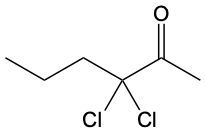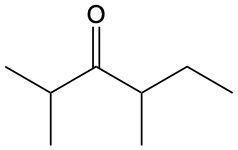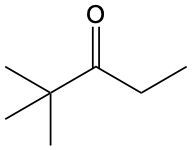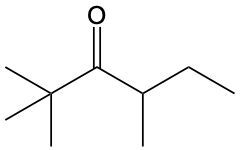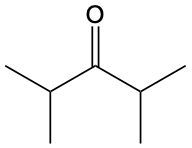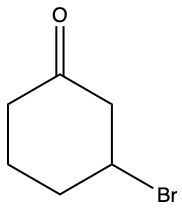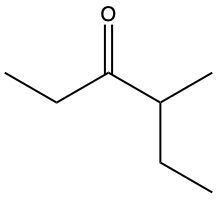Now recall that ketones possess a carbonyl carbon connected to two carbon atoms. Here, the set of rules for naming ketones is similar to those used for naming alcohols. However, the modifier, the ending of 'e' is changed to 'one'. When we talk about the naming convention, we still have to give the locations of different substituents. We then have to give the location of the carbonyl group that is part of the parent chain, and then remember that we're doing a modification to the 'e' ending to 'one'. These are the keys to naming any ketones that we're going to see.
- 1. Matter and Measurements4h 29m
- What is Chemistry?5m
- The Scientific Method9m
- Classification of Matter16m
- States of Matter8m
- Physical & Chemical Changes19m
- Chemical Properties8m
- Physical Properties5m
- Intensive vs. Extensive Properties13m
- Temperature (Simplified)9m
- Scientific Notation13m
- SI Units (Simplified)5m
- Metric Prefixes24m
- Significant Figures (Simplified)11m
- Significant Figures: Precision in Measurements7m
- Significant Figures: In Calculations19m
- Conversion Factors (Simplified)15m
- Dimensional Analysis22m
- Density12m
- Specific Gravity9m
- Density of Geometric Objects19m
- Density of Non-Geometric Objects9m
- 2. Atoms and the Periodic Table5h 23m
- The Atom (Simplified)9m
- Subatomic Particles (Simplified)12m
- Isotopes17m
- Ions (Simplified)22m
- Atomic Mass (Simplified)17m
- Atomic Mass (Conceptual)12m
- Periodic Table: Element Symbols6m
- Periodic Table: Classifications11m
- Periodic Table: Group Names8m
- Periodic Table: Representative Elements & Transition Metals7m
- Periodic Table: Elemental Forms (Simplified)6m
- Periodic Table: Phases (Simplified)8m
- Law of Definite Proportions9m
- Atomic Theory9m
- Rutherford Gold Foil Experiment9m
- Wavelength and Frequency (Simplified)5m
- Electromagnetic Spectrum (Simplified)11m
- Bohr Model (Simplified)9m
- Emission Spectrum (Simplified)3m
- Electronic Structure4m
- Electronic Structure: Shells5m
- Electronic Structure: Subshells4m
- Electronic Structure: Orbitals11m
- Electronic Structure: Electron Spin3m
- Electronic Structure: Number of Electrons4m
- The Electron Configuration (Simplified)22m
- Electron Arrangements5m
- The Electron Configuration: Condensed4m
- The Electron Configuration: Exceptions (Simplified)12m
- Ions and the Octet Rule9m
- Ions and the Octet Rule (Simplified)8m
- Valence Electrons of Elements (Simplified)5m
- Lewis Dot Symbols (Simplified)7m
- Periodic Trend: Metallic Character4m
- Periodic Trend: Atomic Radius (Simplified)7m
- 3. Ionic Compounds2h 18m
- Periodic Table: Main Group Element Charges12m
- Periodic Table: Transition Metal Charges6m
- Periodic Trend: Ionic Radius (Simplified)5m
- Periodic Trend: Ranking Ionic Radii8m
- Periodic Trend: Ionization Energy (Simplified)9m
- Periodic Trend: Electron Affinity (Simplified)8m
- Ionic Bonding6m
- Naming Monoatomic Cations6m
- Naming Monoatomic Anions5m
- Polyatomic Ions25m
- Naming Ionic Compounds11m
- Writing Formula Units of Ionic Compounds7m
- Naming Ionic Hydrates6m
- Naming Acids18m
- 4. Molecular Compounds2h 18m
- Covalent Bonds6m
- Naming Binary Molecular Compounds6m
- Molecular Models4m
- Bonding Preferences6m
- Lewis Dot Structures: Neutral Compounds (Simplified)8m
- Multiple Bonds4m
- Multiple Bonds (Simplified)6m
- Lewis Dot Structures: Multiple Bonds10m
- Lewis Dot Structures: Ions (Simplified)8m
- Lewis Dot Structures: Exceptions (Simplified)12m
- Resonance Structures (Simplified)5m
- Valence Shell Electron Pair Repulsion Theory (Simplified)4m
- Electron Geometry (Simplified)8m
- Molecular Geometry (Simplified)11m
- Bond Angles (Simplified)11m
- Dipole Moment (Simplified)15m
- Molecular Polarity (Simplified)7m
- 5. Classification & Balancing of Chemical Reactions3h 17m
- Chemical Reaction: Chemical Change5m
- Law of Conservation of Mass5m
- Balancing Chemical Equations (Simplified)13m
- Solubility Rules16m
- Molecular Equations18m
- Types of Chemical Reactions12m
- Complete Ionic Equations18m
- Calculate Oxidation Numbers15m
- Redox Reactions17m
- Spontaneous Redox Reactions8m
- Balancing Redox Reactions: Acidic Solutions17m
- Balancing Redox Reactions: Basic Solutions17m
- Balancing Redox Reactions (Simplified)13m
- Galvanic Cell (Simplified)16m
- 6. Chemical Reactions & Quantities2h 35m
- 7. Energy, Rate and Equilibrium3h 46m
- Nature of Energy6m
- First Law of Thermodynamics7m
- Endothermic & Exothermic Reactions7m
- Bond Energy14m
- Thermochemical Equations12m
- Heat Capacity19m
- Thermal Equilibrium (Simplified)8m
- Hess's Law23m
- Rate of Reaction11m
- Energy Diagrams12m
- Chemical Equilibrium7m
- The Equilibrium Constant14m
- Le Chatelier's Principle23m
- Solubility Product Constant (Ksp)17m
- Spontaneous Reaction10m
- Entropy (Simplified)9m
- Gibbs Free Energy (Simplified)18m
- 8. Gases, Liquids and Solids3h 25m
- Pressure Units6m
- Kinetic Molecular Theory14m
- The Ideal Gas Law18m
- The Ideal Gas Law Derivations13m
- The Ideal Gas Law Applications6m
- Chemistry Gas Laws16m
- Chemistry Gas Laws: Combined Gas Law12m
- Standard Temperature and Pressure14m
- Dalton's Law: Partial Pressure (Simplified)13m
- Gas Stoichiometry18m
- Intermolecular Forces (Simplified)19m
- Intermolecular Forces and Physical Properties11m
- Atomic, Ionic and Molecular Solids10m
- Heating and Cooling Curves30m
- 9. Solutions4h 10m
- Solutions6m
- Solubility and Intermolecular Forces18m
- Solutions: Mass Percent6m
- Percent Concentrations10m
- Molarity18m
- Osmolarity15m
- Parts per Million (ppm)13m
- Solubility: Temperature Effect8m
- Intro to Henry's Law4m
- Henry's Law Calculations12m
- Dilutions12m
- Solution Stoichiometry14m
- Electrolytes (Simplified)13m
- Equivalents11m
- Molality15m
- The Colligative Properties15m
- Boiling Point Elevation16m
- Freezing Point Depression9m
- Osmosis16m
- Osmotic Pressure9m
- 10. Acids and Bases3h 29m
- Acid-Base Introduction11m
- Arrhenius Acid and Base6m
- Bronsted Lowry Acid and Base18m
- Acid and Base Strength17m
- Ka and Kb12m
- The pH Scale19m
- Auto-Ionization9m
- pH of Strong Acids and Bases9m
- Acid-Base Equivalents14m
- Acid-Base Reactions7m
- Gas Evolution Equations (Simplified)6m
- Ionic Salts (Simplified)23m
- Buffers25m
- Henderson-Hasselbalch Equation16m
- Strong Acid Strong Base Titrations (Simplified)10m
- 11. Nuclear Chemistry56m
- BONUS: Lab Techniques and Procedures1h 38m
- BONUS: Mathematical Operations and Functions47m
- 12. Introduction to Organic Chemistry1h 34m
- 13. Alkenes, Alkynes, and Aromatic Compounds2h 12m
- 14. Compounds with Oxygen or Sulfur1h 6m
- 15. Aldehydes and Ketones1h 1m
- 16. Carboxylic Acids and Their Derivatives1h 11m
- 17. Amines38m
- 18. Amino Acids and Proteins1h 51m
- 19. Enzymes1h 37m
- 20. Carbohydrates1h 46m
- Intro to Carbohydrates4m
- Classification of Carbohydrates4m
- Fischer Projections4m
- Enantiomers vs Diastereomers8m
- D vs L Enantiomers8m
- Cyclic Hemiacetals8m
- Intro to Haworth Projections4m
- Cyclic Structures of Monosaccharides11m
- Mutarotation4m
- Reduction of Monosaccharides10m
- Oxidation of Monosaccharides7m
- Glycosidic Linkage14m
- Disaccharides7m
- Polysaccharides7m
- 21. The Generation of Biochemical Energy2h 8m
- 22. Carbohydrate Metabolism2h 22m
- 23. Lipids2h 26m
- Intro to Lipids6m
- Fatty Acids25m
- Physical Properties of Fatty Acids6m
- Waxes4m
- Triacylglycerols12m
- Triacylglycerol Reactions: Hydrogenation8m
- Triacylglycerol Reactions: Hydrolysis13m
- Triacylglycerol Reactions: Oxidation7m
- Glycerophospholipids15m
- Sphingomyelins13m
- Steroids15m
- Cell Membranes7m
- Membrane Transport10m
- 24. Lipid Metabolism1h 45m
- 25. Protein and Amino Acid Metabolism1h 37m
- 26. Nucleic Acids and Protein Synthesis2h 54m
- Intro to Nucleic Acids4m
- Nitrogenous Bases16m
- Nucleoside and Nucleotide Formation9m
- Naming Nucleosides and Nucleotides13m
- Phosphodiester Bond Formation7m
- Primary Structure of Nucleic Acids11m
- Base Pairing10m
- DNA Double Helix6m
- Intro to DNA Replication20m
- Steps of DNA Replication11m
- Types of RNA10m
- Overview of Protein Synthesis4m
- Transcription: mRNA Synthesis9m
- Processing of pre-mRNA5m
- The Genetic Code6m
- Introduction to Translation7m
- Translation: Protein Synthesis18m
Naming Ketones - Online Tutor, Practice Problems & Exam Prep
 Created using AI
Created using AIKetones are carbonyl compounds with a carbonyl carbon connected to two carbon atoms. Their naming follows similar rules to alcohols, changing the 'e' ending to '-one' and indicating the carbonyl group's location. Common names exist for specific ketones like acetone, acetophenone, and benzophenone, while others are named by listing the two alkyl groups alphabetically followed by "ketone." Understanding these naming conventions is essential for identifying and classifying ketones in organic chemistry.
IUPAC Rules for Naming Ketones Concept 1
Video transcript
Naming Ketones Example 1
Video transcript
Here it says, provide the formal name for the ketone shown. Now to do that, we're going to use the following steps. Step 1 is to find the longest carbon chain, which represents our parent chain, and assign a name according to the prefixes and the modifier. The parent chain should include the carbonyl group. So remember, your carbonyl carbon or carbonyl group is this, C double bond O, and have a greater number of carbons. If there is a tie between the longest chains, choose the chain with more substituents. If we take a look here, our longest carbon chain would be this portion here. Now assign a name to all substituents for step 2. Our substituent here would be this carbon that's branching off of the main chain, which would be a methyl group. Step 3. Start numbering the chain from the end closest to the carbonyl carbon. So we'd have to start numbering from this end. 1, 2, 3, 4, 5, 6, 7, 8. If a tie, the number from the end closest to the next substituent. If still a tie, number in alphabetical order in terms of the substituents. And then here, assign a location to the carbonyl carbon. The carbonyl carbon is on carbon number 2. Alright. And then we repeat steps 4 to 6, and these are from previous naming topics. Mainly, if we're looking at alkanes with substituents, that's where we're coming up with these rules or steps 4 to 6. If you haven't watched that video, make sure you go back and take a look. Because in it, we talk about our substituents. They're written at the beginning of the name; we have to give their location, numerical location. And if there's multiple substituents, we have to name them alphabetically. So here if we take a look, we're going to say our substituent is on Carbon 5, so it's 5-methyl. The carbonyl carbon is on Carbon 2, so it becomes 2-octanone. So this would be the name of this particular ketone, 5-methyl-2-octanone.
Provide the systematic name for the following ketone.
3,3-dichloro-5-hexanone
4,4-dichloro-5-hexanone
4,4-dichloro-2-hexanone
3,3-dichloro-2-hexanone
Which of the following compounds represent 2,4-dimethyl-3-pentanone?
Provide the systematic name for the following cyclic ketone.
1-bromo-3-cyclohexanone
3-bromocyclohexone
3-bromocyclohexanone
1-bromo-3-cyclohexone
Common Naming of Ketones Concept 2
Video transcript
Now when it comes to common naming, we're going to say that certain ketones have unique names given before the IUPAC naming system was developed. Now the unique ones apply to these three structures here. In the first one, we have our carbonyl group, and it's connected to 2 methyl groups, 1 on each side. It is a ketone, and usually, we change the e ending of our alkane structure to -one to reflect the ketone. Here, this becomes acetone. The next one, we have a carbonyl connected to 1 benzene ring on the left and this methyl group here on the right. Here, we're going to say that this is called acetophenone. Phenone because we're dealing with a phenyl ring. Remember, phenyl implies that we're dealing with a benzene ring. So this structure here. And then in this one, we have a carbonyl group with 2 benzene rings attached to it. This is known as Benzophenone. One of the benzene rings gives us the first part of the name benzo, and then the other benzene ring gives us the phenone at the end. Now here we're going to say that for the rest of the ketones, the common name consists of 2 alkyl groups, names followed by ketone. So the naming convention would be substituent 1, substituent 2, listed alphabetically, and then we end the name with ketone. So this is the rule we're going to apply when it comes to the common names of several types of ketones. But remember, these three particular ones have unique names that were developed before IUPAC naming systems were ever developed.
Naming Ketones Example 2
Video transcript
In this example question it says, provide a common name for the ketone shown. Alright. So here goes our ketone structure. In step 1, we have to identify the 2 alkyl groups connected to the carbonyl carbon. Remember, your carbonyl carbon is just a carbon double bonded to the oxygen. Connected to it is this alkyl group, which is one carbon, that's a methyl group, and then we have this carbon chain here. It consists of 3 carbon atoms. 1, 2, 3. So that would be propyl. So we've identified the 2 alkyl groups connected to my carbonyl carbon.
Step 2, name the alkyl groups alphabetically as substituents. Kind of jumped the gun here, we have already identified them as methyl and propyl. Now if they are identical alkyl groups, we use a numerical prefix di. So if they both were methyl groups, we'd say dimethyl. If they both were propyl groups, we'd say dipropyl.
Step 3, we end name of the compound with ketone, and write the names with spaces. So alphabetically, m comes before p, so this would be methyl propyl ketone. So its common name will be methylpropylketone.
Give common name for following ketone.
sec-butyl ethyl ketone
sec-butyl propyl ketone
ethyl sec-butyl ketone
propyl sec-butyl ketone
Provide common name for given ketone.
p-isopropyl acetophenone ketone
4-isopropyl acetophenone
p-isobutyl ketone
4-isobutyl acetophenone
Do you want more practice?
Here’s what students ask on this topic:
What are the rules for naming ketones according to IUPAC nomenclature?
In IUPAC nomenclature, ketones are named by identifying the longest carbon chain that includes the carbonyl group. The suffix '-e' of the parent alkane is replaced with '-one'. The position of the carbonyl group is indicated by the lowest possible number. For example, in pentan-2-one, the carbonyl group is on the second carbon of a five-carbon chain. Additionally, any substituents are named and their positions are indicated. The general formula for naming ketones is: [position of carbonyl]-[parent chain]-one.
 Created using AI
Created using AIHow do you name ketones with common names?
Common names for ketones are often derived from the names of the alkyl groups attached to the carbonyl carbon, followed by the word 'ketone'. For example, if the carbonyl group is attached to a methyl group and an ethyl group, the ketone is called methyl ethyl ketone. Some ketones have unique common names, such as acetone (propanone), acetophenone (1-phenylethanone), and benzophenone (diphenyl ketone). These names were established before the IUPAC system and are still widely used.
 Created using AI
Created using AIWhat is the difference between acetone, acetophenone, and benzophenone?
Acetone, acetophenone, and benzophenone are specific ketones with unique common names. Acetone (propanone) has a carbonyl group attached to two methyl groups. Acetophenone (1-phenylethanone) has a carbonyl group attached to a phenyl group and a methyl group. Benzophenone (diphenyl ketone) has a carbonyl group attached to two phenyl groups. These names were established before the IUPAC system and are still commonly used in both academic and industrial settings.
 Created using AI
Created using AIHow do you determine the position of the carbonyl group in a ketone?
To determine the position of the carbonyl group in a ketone, identify the longest carbon chain that includes the carbonyl carbon. Number the chain from the end nearest to the carbonyl group to give the carbonyl carbon the lowest possible number. The position of the carbonyl group is then indicated by this number in the ketone's name. For example, in butan-2-one, the carbonyl group is on the second carbon of a four-carbon chain.
 Created using AI
Created using AIWhat are the key differences between naming ketones and alcohols?
While naming ketones and alcohols follows similar rules, there are key differences. For ketones, the suffix '-e' of the parent alkane is replaced with '-one', and the position of the carbonyl group is indicated by a number. For alcohols, the suffix '-e' is replaced with '-ol', and the position of the hydroxyl group is indicated by a number. Additionally, ketones have a carbonyl group (C=O) while alcohols have a hydroxyl group (OH).
 Created using AI
Created using AIYour GOB Chemistry tutor
- Draw a structure for a compound that meets each of the following descriptions:A cyclic alpha-hydroxyketone, C₅...
- Redraw each of the following in line structure format. Indicate which compounds have an aldehyde carbonyl grou...
- Redraw each of the following in line structure format. Indicate which compounds have an aldehyde carbonyl grou...
- Draw structures corresponding to the following aldehyde and ketone names:1,1,1-Trichloro-3-pentanone
- Give IUPAC names for the following aldehydes and ketones: <IMAGE>
- The following names are incorrect. What is wrong with each?1-Pentanone
- Give systematic, IUPAC names for the following compounds. Redraw each in line structure format. ...
- Draw all the ketones you can with a chemical formula of C₈H₁₆O whose longest chain is eight carbons. Name each...
- Draw the structural formulas of the following compounds:2-Methoxy-2-methylpropane
- The compound carvone is responsible for the odor of spearmint. Identify the functional groups in carvone. <...
- Draw a structure for a compound that meets each of the following descriptions:A 6-carbon cyclic ketone with a ...
- Draw a structure for a compound that meets each of the following descriptions:An 8-carbon ketone with six carb...
- Aldosterone is a key steroid involved in controlling the sodium–potassium balance in the body. Identify the fu...
- Give the IUPAC name for each of the following: (12.3)c. <IMAGE>
- Compound X is a secondary alcohol whose formula is C₃H₈O. When compound X is heated with strong acid, it dehyd...
- Give the IUPAC name for each of the following:b. <IMAGE>
- Give the common name for each of the following:b. <IMAGE>
- Give the IUPAC name for each of the following:c. <IMAGE>
- Draw the condensed structural formula for each of the following:b. 4-chloro-2-pentanone
- Draw the condensed structural formula for each of the following:c. butyl methyl ketone
